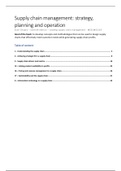Samenvatting
Summary book supply chain management: strategy, planning and operation 7th edition
- Instelling
- Hogeschool Rotterdam (HR)
Seventh edition! Summary excluding mathematical parts. Perfect to prepare for the exam and convenient to have during the exam Samenvatting kort maar duidelijk, perfect om door te nemen voor tentamen en handig om snel feiten op te zoeken
[Meer zien]





